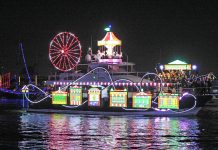More than a dozen people discussed the pilot program for the Multiple Vessel Mooring System during the MVMS Ad Hoc Committee meeting on Tuesday.
“With this initiative the city is, in my view, taking a real interest in the harbor,” said Harbor Commissioner Brad Avery, chairman of the ad hoc committee. It may not hit other stakeholder’s ideas “squarely on the head,” but this is “worthy of trying.”
The committee agreed to test six docks, three in mooring field C, and one each in C, D and F fields, over a 12-month trial period. They should be about 50-feet long and five-feet wide.
The rough estimate of $50 per square foot, or $12,500, for just the float, said Harbor Resources Manager Chris Miller . That doesn’t include certain mechanisms or system equipment, Miller explained, which could round the number up to about $20,000 per float. That’s a very rough estimate, he emphasized, but it is good a base point for a wooden dock.
For the purpose of the trial, the committee decided not include electricity or solar panels.
They are working with a short timeline, Avery said, and hope to deliver something in June.
The committee should be able to present something to the city council within 60 days, Miller said. They may direct the committee to go forward with the plan, make changes or something else altogether, he explained.
Avery considered the ultimate goal of the committee.
“What are we trying to do here?” Avery said. “Ostensibly, it’s to deliver more service, more value to the moorings.”
It’s about figuring out what will work as a trial, Avery clarified, not what would be a permanent or future project.
“What we want to do is basically find out whether this is feasible and… more importantly, whether people like it,” he said. “Whether is adds value to the citizens of Newport, visiting yachts people, the harbor itself, and, perhaps most importantly, to the mooring lease holders.”
It needs to be a balance, he said.
“Sounds like the most important thing is the impact on the community, the stakeholders in the community” said Paul Gerst.
That needs to be measured and considered, he said.
There is quite a bit of concern among some mooring holders.
“The mooring permit holders have accrued a fair distrust of the city, and not without reason,” George Hylkema said. So “when the mayor says he wants to do something for the moorings we’re a little suspicious.”
He suggested that something be done to assure mooring permit holders that the use of their moorings “as is” is not threatened by this, he said, that there won’t be any kind of mandatory participation.
Participation in the trial is not mandatory and nobody is going to lose their moorings, Avery said, but it can’t be guaranteed that, if the new floating system gets put into place, there would be an opt-out option. They just can’t predict that as of right now, he said.
“This is just a trial,” Avery said. “What happens after this is a whole other story.”
The committee is just here for the pilot project, Miller explained, they aren’t tasked with deciding something like that for the long-term. Nor do they have the authority, Avery added.
Any new moorings would have to be approved by the city, Miller said.
Adding new moorings goes against the whole idea of the committee, Avery said.
“I think we can state that clearly,” he declared.
The group was still considering the Helix/Seaflex system versus the existing system and will discuss the item further at an upcoming meeting.
The next meeting will be in two weeks.




